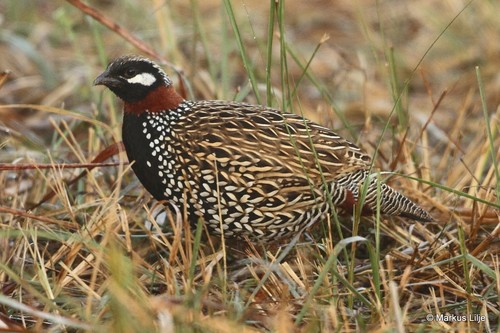
Black Francolin
The Black Francolin (*Francolinus francolinus*) is a striking game bird belonging to the pheasant family. Known for its distinctive calls and bold plumage in males, it plays a significant role in its ecosystem as both a seed disperser and prey for larger animals. This species holds cultural significance in parts of its range, often featured in folklore and traditional hunting practices. It's a popular species for birdwatchers due to its conspicuous nature and the male's eye-catching appearance.
33-36 cm
Length
50-56 cm
Wingspan
Least Concern
Conservation Status
Distribution
The Black Francolin has a wide distribution, ranging from Cyprus and southeastern Turkey through the Middle East and into Central Asia, including parts of India, Nepal, and Bangladesh. Some introduced populations also exist outside this native range.
Lifespan
Typically 1-2 years in the wild, though they can live longer in captivity.
Black Francolin's Habitat
Habitat Types
Grasslands, Scrublands, Agricultural areas with sufficient cover, Open woodlands
Climate Zones
Subtropical, Temperate
Adaptations
Their strong legs are adapted for running and scratching the ground to find food. They prefer areas with dense ground cover for protection from predators.
Variations
Several subspecies are recognized, differing slightly in plumage and size across their extensive range. For instance *F. f. asiae* in India is larger, and paler than *F. f. francolinus*.
Appearance
Breeding Plumage
Males have a striking black head, breast, and belly, with a chestnut collar and white spotting on the flanks during breeding season. Non-breeding males may have slightly duller coloration. Females are predominantly brown with intricate barring and spotting, providing excellent camouflage.
Seasonal Feather Changes
Slight dulling of male plumage outside of breeding season.
Sex Based Plumage Differences
Significant. Males are much more brightly colored than females.
Notable Features
White cheek patch on males, Rufous collar on males, Strong, sturdy legs
Diet and Feeding
Primary Foods
Seeds, Grains, Insects, Small invertebrates, Shoots, Berries
Foraging Behavior
Black Francolins primarily forage on the ground, scratching and pecking at the soil to uncover food. They are often seen foraging in small groups or pairs.
Specializations
Their strong beaks are well-suited for cracking seeds and picking up small insects.
Seasonal Diet Variations
Diet may shift depending on food availability. For example, they may consume more insects during the breeding season when protein requirements are higher.
Behavior
Social Structure
Generally found in pairs or small family groups. Larger groups may form outside of the breeding season.
Communication
Loud, distinctive calls (especially by males), Visual displays (e.g., short flights, raising of head feathers)
Migration
Largely resident (non-migratory), though some populations may undertake short-distance movements in response to food availability or weather conditions.
Territorial or Group Behaviors
Males are territorial during the breeding season, defending their chosen area against rivals.
Conservation
Threats
Habitat loss (due to agriculture and urbanization), Hunting pressure, Pesticide use
Protection Programs
Habitat restoration projects in some areas, Hunting regulations in certain regions
Local National Laws
Protected under wildlife laws in many countries within its range.
Population Trend
Stable
Population Estimates
While the global population is large and not currently considered threatened, localized declines have been observed in some areas due to habitat loss.
Interesting Facts
The Black Francolin's call is often described as one of the characteristic sounds of the countryside in its native range.
The loud, far-carrying call is used for communication and territorial defense.
The Black Francolin is the state bird of Haryana, India.
It reflects the bird's cultural significance in that region.
They are strong fliers but prefer to run to escape danger.
This is a common trait among ground-dwelling birds.
Faqs about Black Francolin
What is the difference between a male and female Black Francolin?
Males are much more brightly colored, with black plumage, a white cheek patch, and a rufous collar. Females are predominantly brown and camouflaged.
Are Black Francolins endangered?
No, they are currently classified as Least Concern by the IUCN. However, localized populations may face threats.
What do Black Francolins eat?
They have a varied diet consisting of seeds, grains, insects, and other small invertebrates.
Copyright @ Nature Style Limited. All Rights Reserved.
 English
English